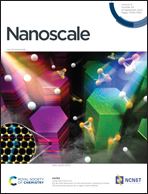Direction observation of the grain boundary segregation in molybdenum substituted lanthanum tungstate membranes†
Abstract
Molybdenum substituted lanthanum tungstate membranes (LWO-Mo) offer a good alternative for the separation of hydrogen from gas mixtures. During several essential steps of the membrane processing, an intensive employment of ZrO2 milling balls is usually inevitable. However, how these milling balls affect the final LWO-Mo membranes, is still largely unknown. Employing comprehensive transmission electron microscopy (TEM) techniques, the residual Zr was found to segregate to the grain boundaries (GBs) of the LWO-Mo, either as thin layers or as individual nanograins. At atomic scale, structural and chemical analyses on these GB features were carried out quantitatively. The segregated Zr took more than half of the W sites of the LWO-Mo, resulting in a strained LWO structure and locally concentrated oxygen vacancies. To minimize any Zr contamination, either a competent alternative for ZrO2 or a careful introduction of certain secondary phases (SPs) was proposed. Our results unravel the processing-induced GB behaviors in LWO-Mo, which pave the way towards further optimized processing for various types of functional membranes.



 Please wait while we load your content...
Please wait while we load your content...